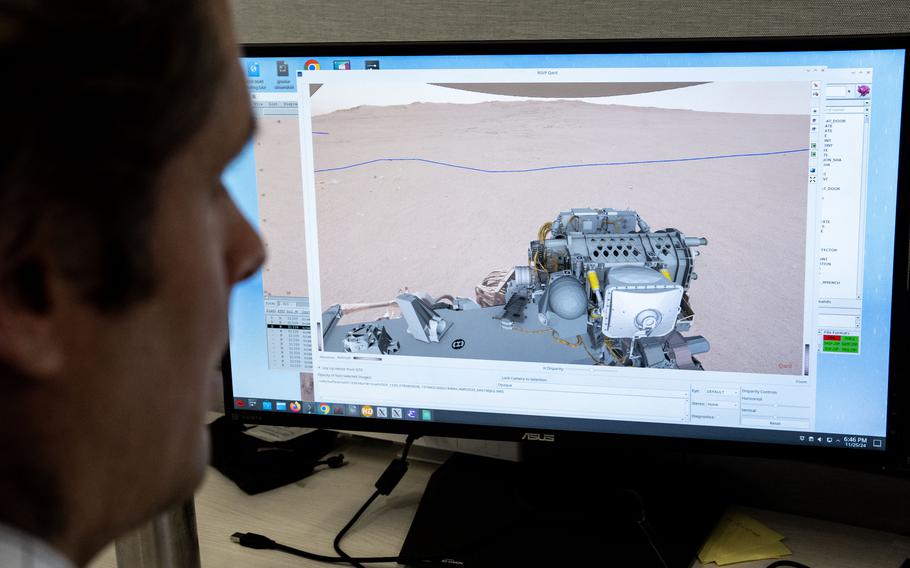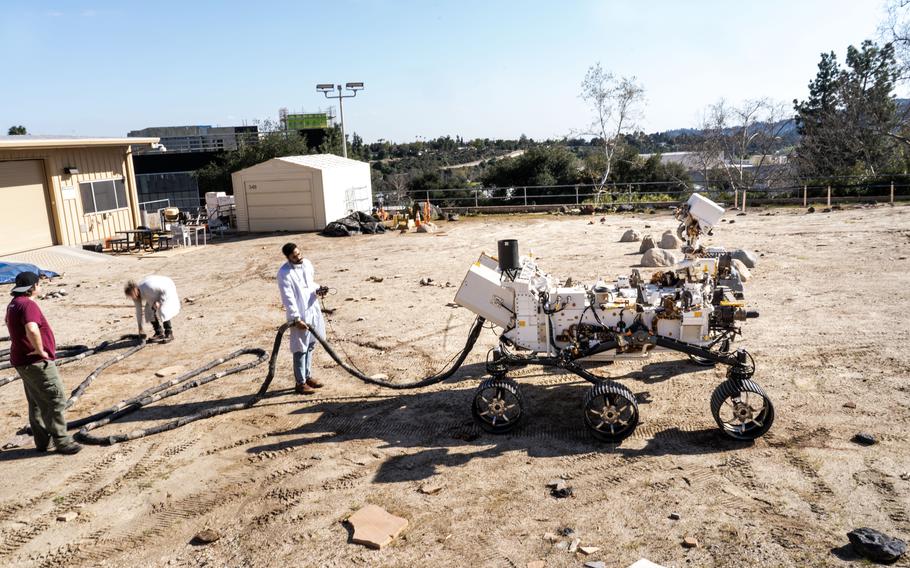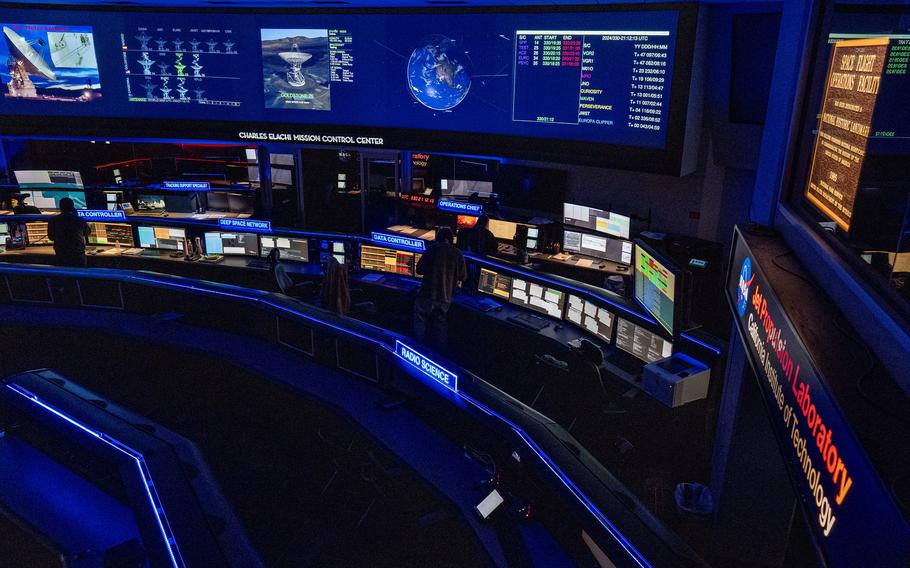
Perseverance rover driver Joseph Carsten plans a route. (Melina Mara/The Washington Post)
PASADENA, Calif. — John Michael Morookian’s daily commute is 31 miles one-way, a stop-and-go journey through heinous Southern California traffic. It can easily take an hour. When he finally gets to his computer terminal in Building 230 of the NASA Jet Propulsion Laboratory, he does more driving. The pace is slower yet. In fact the vehicle he drives never goes faster than about 0.1 mph.
Because he drives a rover on Mars.
Morookian is one of two dozen employees at the lab who drive Perseverance, a $2 billion, six-wheeled NASA robot exploring a distant planet covered in rocks, boulders, sand dunes and craters. The team this year has been driving the rover up the steep slopes of Jezero Crater, hoping to reach what they call Lookout Hill on the crest of the crater rim.
That drive has proved to be a slog.
Perseverance has climbed steep slopes before and can drive across steep terrain even when tilting sharply to the side. It has also endured slippery soil. But until this journey onto the crater rim, the rover hadn’t handled such a combination of steep, tilted and slippery.
And Mars is essentially one hazard after another. The mantra of the team: Keep the rover safe. Ensure that whatever happens, Perseverance can drive another day.
“There’s no AAA for Mars,” rover driver Sean McGill says. “We cannot go and correct a mistake we might have made.”
On a recent Monday, 1340 sols (Martian days) had passed since Perseverance landed on the Red Planet in 2021. Inside a room filled with computers and large data-filled screens, the drivers were confronted with an unusual challenge: They had to plan three days’ worth of commands dictating where Perseverance should go and how fast to get there to allow the humans on Earth to take a Thanksgiving break.
The goal was to cover a lot of ground, a total of 635 meters (a little more than 2,000 feet). A mad dash, by Mars rover standards. (The one-day distance record for Perseverance is 347.689 meters on sol 753.)
This interplanetary navigation by rover drivers comes at an uncertain moment for NASA’s Mars program. Perseverance has been gathering and stashing small tubes of Martian soil and rocks for future study back on Earth. NASA for several years has been formulating an ambitious mission called Mars Sample Return, but it remains aspirational, with no hardware yet launched to fetch the samples. The mission could cost between $8 billion and $11 billion, and would not get the samples to Earth until 2040, an independent review board estimated in 2023.
Senators on Capitol Hill were aghast. So were NASA officials, who earlier this year put everything on hold, asking for proposals from private industry as well as JPL for mission architectures that could lead to a cheaper, faster sample return. The agency said it will report its findings by the end of this year. In the meantime JPL, a fabled institution that is managed for NASA by Caltech, endured two significant rounds of layoffs since February.
More uncertainties loom as the second Trump administration takes control of NASA. Right now it is not at all clear how or when the samples will get to Earth. Or if.
Perseverance is sending back science in any event, using imagery to study the geology of the 28-mile-wide Jezero Crater. Following its landing, the rover spent nearly seven months exploring the basin of the crater, then climbed onto the remains of rocks deposited by a river delta.
Along the way it cached samples of Martian soil, leaving some on the crater floor for eventual retrieval and depositing others inside the rover itself. The team wants to reach the crater rim to study and take samples of what scientists think will be intriguing rocks dating to early in Mars’s history, when the planet was warmer, wetter, hadn’t yet lost most of its atmosphere and become a desert world, and possibly was home to primitive life.

Scientists operate a Mars rover within the Mars yard at JPL in 2023. (Melina Mara/The Washington Post)
Martian sunsets and roaming rovers
Mars looks a lot like the desert in the American Southwest, minus the cacti, rattlesnakes, tourist attractions and truck stops. To Morookian’s eyes that distant planet is familiar turf, and the otherwordliness of it only hits him when he sees a full-color image of a Martian sunrise or sunset: “Those are blue on Mars.”
The rover drivers are called “rover planners,” or RPs. There is no joysticking a Mars rover, because it’s so far away that a command sent at the speed of light across interplanetary space takes four to 24 minutes to arrive. Driving always takes place in Martian daylight. (The rover lacks headlights.)
“It’s one of the coolest jobs you could have. How many people can say they’re a Mars rover driver?” says McGill, 32, who once dreamed of a career in film and wound up getting degrees in astronomy and aerospace engineering.
About 90% of Perseverance’s navigation is autonomous. It has an on-board system called AutoNav, which is just as it sounds, an ability to analyze the landscape and make prudent, conservative decisions about how to get from point A to point B without plunging into a hole and getting stuck in a sand dune. This has happened before: The Mars rover Spirit in 2010 got stuck in soft sand one day and never escaped.
Like its predecessor and nearly identical twin Curiosity, which is still exploring a different crater on Mars, Perseverance has been variously described as the size of a Mini Cooper, a VW Beetle or a small SUV. It is bristling with instruments, including cameras and an all-purpose robotic arm. It can drive backward.
Yet there are hazards everywhere. Drivers need to be the kind of people who are detail-oriented and good at collaboration. The Perseverance team, occupying several rooms separated by large windows and framed by screens flashing data and imagery, holds six meetings a day to develop, review and finalize a driving plan.
The images may show the rover’s view of the landscape, or a perspective from orbit, where the Mars Reconnaissance Orbiter continues to operate splendidly. Technicians can look at images through 3D glasses (much fancier than the ones you get at the cinema).

Senior data controller Marc Suban and data controller Jonathan Estrada monitor data coming from satellites and space craft within JPL’s control center. (Melina Mara/The Washington Post)
‘Mars is always gonna Mars’
On this Monday, three drivers were at their stations, side by side, collaborating on plans for the next three days of driving: Keith Naviaux, 56, Joseph Carsten, 44, and Morookian, 55.
“The level of detail, the kind of information, and the number of things you have to pay attention to is quite large,” said Naviaux, an aerospace engineer with the primary responsibility this time of designing the three-day drive.
“Mars is always gonna Mars. Mars is always gonna surprise you. Mars is an extreme environment. Things just happen,” he said.
Although the rover happened to be in a part of the crater described as “featureless terrain,” without any obvious obstacles directly ahead, that very featurelessness posed a challenge. There is no GPS on Mars, needless to say. The rover sometimes struggles to understand exactly how far it has traveled. It knows how many times its wheels have turned, but the slippery terrain makes that an unreliable estimate of its movements.
So it relies a great deal on “visual odometry.” It moves a little, takes an image, compares it to the previous image and determines how far it has traveled based on visual milestones. But when there’s just an expanse of featurelessness – “The terrain’s a parking lot,” noted driver Camden Miller – the rover can declare a visual odometry fault. It says, in effect, I am not sure how far I’ve gone.
This happens often enough that the planners have the discretion to give the rover some wiggle room. A single fault shouldn’t halt operations. Typically the default setting allows 10 visual odometry faults before the rover calls time out and waits for a new batch of commands from Earth.
But on this day, facing the parking lot-esque traverse, the team didn’t want to lose a great chance to bolt across a long stretch of Martian soil. They gathered, clustering around Carsten’s work station, and devised a way to keep Perseverance rolling even if it got confused: Raise the permissible number of faults to 20.
Smart? Or reckless?
“Going up to 20 seems like a reasonable risk balance,” Morookian said.
“We could potentially be on a steeper hill with higher slip,” cautioned Evan Graser, who had just entered the room and is the deputy strategic route planner lead.
They gamed it out. Pros and cons.
“I talked myself out of being worried,” Graser said. “I think it sounds like fun.”
Decision made: Go to 20, fingers crossed.
Everyone got to have their Thanksgiving break.
Afterward the team learned the traverse didn’t go great. The featureless terrain proved impassable even with the liberal setting on the visual odometry faults. The rover traveled only about 50 meters before it halted and waited for the rover planners to get back on duty.
That was disappointing, but no big deal. Perseverance slogged onward, safe and sound, still churning toward the crest of the crater rim, its long strange trip nearing completion.
As of Friday the rover was only about 350 meters from Lookout Hill. The NASA team hopes any day now it can reveal to the planetary science community the first image from the summit — an interplanetary postcard showing the vast Martian crater from which Perseverance, true to its name, has emerged.